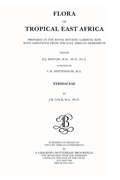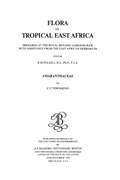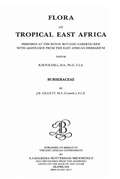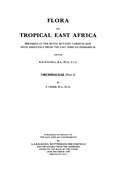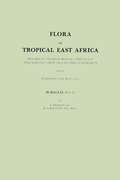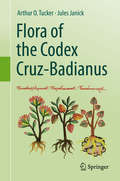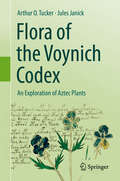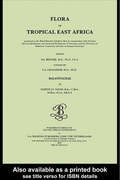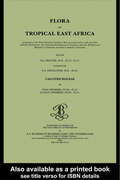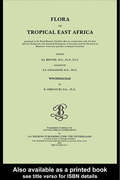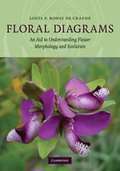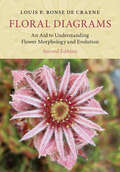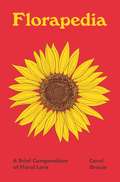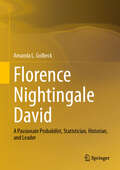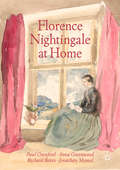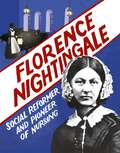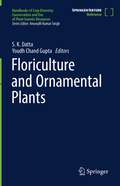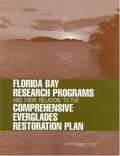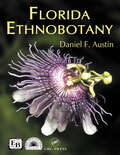- Table View
- List View
Flora of Tropical East Africa - Xyridaceae (1999)
by J. M. LockThe flora is prepared at Royal Botanic Gardens, Kew, in close collaboration with East African Herbarium and in liaison with the University of Dar es Salaam, the University of Nairobi and the Makerere University. Significant contributions are also made by specialists elsewhere. The flora is designed to a high academic standard and should be a useful resource reference for anyone concerned with the identification and utilization of plants in eastern Africa. Each family is published as a separate part.
Flora of Tropical East Africa -Amaranthaceae (1985)
by C. C. TownsendThis volume focuses on the family Amaranthaceae. They are annual or perennial herbs or subshrubs, rarely lianes and large and mainly tropical family of some 65 genera and over 1000 species, including many cosmopolitan weeds and a large number of xerophytic plants.
Flora of Tropical East Africa: Burseraceae (Flora Of Tropical East Africa Ser.)
by J. B. GillettFirst published in 1991. CRC Press is an imprint of Taylor & Francis.
Flora of Tropical East Africa: Orchidaceae (Part 3) (Flora Of Tropical East Africa Ser.)
by P. CribbFirst published in 1989. CRC Press is an imprint of Taylor & Francis.
Flora of Tropical East Africa: Prepared at the Royal Botanic Gardens/Kew With Assistance from the East African Herbarium
by D. BrisdonThe Rubiaceae are a family of flowering plants, commonly known as the coffee, madder, or bedstraw family. This volume was prepared at the Royal Botanic Gardens, Kew with assistance from the East Africain Herbarium. It contains a synopsis of subfamilies and tribe; as well as labelled diagrams.
Flora of the Codex Cruz-Badianus
by Jules Janick Arthur O. TuckerIn 1929, Charles Upson Clark (1975-1960), a history Professor at Columbia University carrying out bibliographic research on the early history of the Americas in the Vatican Library, came across a remarkable illustrated Latin manuscript entitled Libellus de Medicinalibus Indorum Herbis (Little Book of Indian Medicinal Herbs) completed in 1552. The manuscript now known as the Codex Cruz-Badianus (CCB) contained 185 illustrations (phytomorphs) of plants with text that described their medicinal uses. This manuscript spread new light on botanical and medicinal knowledge of the indigenous peoples of Mexico known today as the Nahuas or Aztecs. It was to have major repercussions on our knowledge of Aztec culture and the history of New Spain in the 16th century.CCB was produced at the Colegio of Imperial de Santa Cruz at Tlatelolco established in 1536 to train sons of the Aztec nobility for the clergy. The authors were two indigenous faculty members, Martin (Martinus in Latin) de la Cruz and Juan Badiano (Juannes Badianus in Latin) whose Spanish names were conferred upon their baptism. Martin de la Cruz was the Colegio’s indigenous doctor who gave instruction in medicine and Juan Badiano, a Latin teacher and former student translated the book into Latin.The herbal dedicated to the Viceroy Francisco de Mendoza was sent to Spain as a gift to King Carlos I soon after its completion in 1552. The original ended up in the Vatican Library until 1990 when John Paul II returned it to Mexico. In 1931, the Mayanist scholar, William Gates, and the biologist Emily Walcott Emmart became aware of the manuscript and independently translated it to English. In 2009, Martin Clayton, Luigi Guerrini, and Alejandro de Avila identified plants of the CCB based on Emmart’s book and a 17th century copy found in the Windsor library. Of the 185 phytomophs, Gates identified 85 on the generic level, Emmart 9, and Clayton et al. 126. However most of these identifications disagree. In the present work, 183 of 185 phytomorphs are systematically re-evaluated and identified on the generic, as well as specific level, along with their botanical descriptions, previous identifications, putative identification, distribution, names, and uses.
Flora of the Voynich Codex: An Exploration of Aztec Plants
by Jules Janick Arthur O. TuckerThe Voynich Codex is one the most fascinating and bizarre manuscripts in the world. The manuscript (potentially equivalent to 232 pages), or more properly a codex, consists of many foldout pages. It has been divided by previous researchers into sections known as Herbal/Botanical/Pharmacology; Balenological/Biological; Cosmology; one page known as The Rosette; and a final Recipe section. All the sections contain text in an unknown writing system, yet to be deciphered. Cryptological analyses by modern computer programs nevertheless have determined that the language is real and not a hoax, as has been suggested by some. Despite the fact that this codex is largely an herbal, the interpreters of this manuscript with two exceptions, have not been botanists. To this end, our recent research suggests that the Voynich is a 16th century codex associated with indigenous Indians of Nueva España educated in schools established by the Spanish. This is a breakthrough in Voynich studies. We are convinced that the Voynich codex is a document produced by Aztec descendants that has been unfiltered through Spanish editors. The flora of New Spain is vast, and the medicinal and culinary herbs used by the Aztecs were equally as copious. Even though it is our hypothesis that the Voynch Codex was written as a private herbal in 16th century New Spain, many of these herbs have relevance today because they or closely related species have been noted to be medicinal or have culinary value. The Voynich Codex has an estimated 359 illustration of plants (phytomorphs), 131 in the Herbal Section (large images) and 228 in the Pharmaceutical Section (small images of plant parts). In our book “Unraveling of the Voynich Codex”, to be published by Springer this summer, Tucker and Janick have partially identified species in the Herbal Section. In this proposed work, all of the plants of the Herbal Section will be identified along with those plants of the Pharmacology Section where identification is feasible. Each plant identification will include subdivisions to include descriptors (formal botanical identification), names in English, Spanish, and Mesoamerican names where known, ecology and range, and properties (medicinal and culinary) of these and related species. Photographs of the phytomorphs and contemporary plants will be included. These identifications represent hard evidence that the Voynich Codex is a 16th Century Mexican manuscript. Exploring the herbs of the Aztecs through the Voynich Codex will be a seminal work for all Voynich researchers and also of interest to a wider audience in medicinal and culinary herbs, artists, and historians. In summary, our new book project Flora of the Voynich Codex will provide a photo-illustrated guide to complete the botanical evidence related to the Voynich Codex, one of the most valuable historic texts of the 16th century.
Flora of tropical East Africa - Balanitaceae (2003)
by H. J. Beentje S. A. GhazanfarPrepared at the Royal Botanic Gardens, Kew, in close collaboration with the East African Herbarium and in liaison with the University of Dar es Salaam, the University of Nairobi and the Makerere University, this series is designed to the highest academic standards and is a useful reference for anyone concerned with the identification and utilizatio
Flora of tropical East Africa - Callitrichaceae (2003)
by H. J. Beentje S. A. GhazanfarPrepared at the Royal Botanic Gardens, Kew, in close collaboration with the East African Herbarium and in liaison with the University of Dar es Salaam, the University of Nairobi and the Makerere University, this series is designed to the highest academic standards and is a useful reference for anyone concerned with the identification and utilizatio
Flora of tropical East Africa - Woodsiaceae (2003)
by B. Verdcourt H. J. Beentje S. A. GhazanfarPrepared at the Royal Botanic Gardens, Kew, in close collaboration with the East African Herbarium and in liaison with the University of Dar es Salaam, the University of Nairobi and the Makerere University, this series is designed to the highest academic standards and is a useful reference for anyone concerned with the identification and utilizatio
Floral Diagrams: An Aid to Understanding Flower Morphology and Evolution
by Louis P. Ronse De CraeneFloral morphology remains the cornerstone for plant identification and studies of plant evolution. This guide gives a global overview of the floral diversity of the angiosperms through the use of detailed floral diagrams. These schematic diagrams replace long descriptions or complicated drawings as a tool for understanding floral structure and evolution. They show important features of flowers, such as the relative positions of the different organs, their fusion, symmetry, and structural details. The relevance of the diagrams is discussed, and pertinent evolutionary trends are illustrated. The range of plant species represented reflects the most recent classification of flowering plants based mainly on molecular data, which is expected to remain stable in the future. This book is invaluable for researchers and students working on plant structure, development and systematics, as well as being an important resource for plant ecologists, evolutionary botanists and horticulturists.
Floral Diagrams: An Aid to Understanding Flower Morphology and Evolution
by Louis P. Ronse De CraeneFloral morphology is key for understanding floral evolution and plant identification. Floral diagrams are two-dimensional representations of flowers that replace extensive descriptions or elaborate drawings to convey information in a clear and unbiased way. Following the same outline as the first edition, this comprehensive guide includes updated and relevant literature, represents the latest phylogeny, and features 28 new diagrams. Diagrams are presented in the context of the most recent classifications, covering a variety of families and illustrating the floral diversity of major groups of plants. A strong didactic tool for observing and understanding floral structures, these diagrams are the obvious counterpart to any genetic study in flowering plants and to the discussion of major adaptations and evolutionary trends of flowers. This book is invaluable for researchers and students working on plant structure, development and systematics, as well as being an important resource for plant ecologists, evolutionary botanists and horticulturists.
Florapedia: A Brief Compendium of Floral Lore (Pedia Books)
by Carol GracieA delightful illustrated treasury of botanical facts and fancyFlorapedia is an eclectic A–Z compendium of botanical lore. With more than 100 enticing entries—on topics ranging from achlorophyllous plants that use a fungus as an intermediary to obtain nutrients from other plants to zygomorphic flowers that admit only the most select pollinators—this collection is a captivating journey into the realm of botany.Writing in her incomparably engaging style, Carol Gracie discusses remarkable plants from around the globe, botanical art and artists, early botanical explorers, ethnobotanical uses of plants, botanical classification and terminology, the role of plants in history, and more. She shares illuminating facts about van Gogh's sunflowers and reveals how a hallucinogenic weed left its enduring mark on the early history of the Jamestown colony. Gracie describes the travels of John and William Bartram—father and son botanists and explorers who roamed widely in early America in search of plants—and delves into the miniature ecosystems entangled in Spanish moss. The book's convenient size allows for it to be tucked into a pocket or bag, making it the perfect companion on your own travels.With charming drawings by Amy Jean Porter, Florapedia is the ideal gift book for the plant enthusiast in your life and a rare pleasure for anyone interested in botanical art, history, medicine, or exploration.
Florence Nightingale David: A Passionate Probabilist, Statistician, Historian, and Leader
by Amanda L. GolbeckThis book examines Florence Nightingale David's life, contributions, and relationships throughout her life, as well as her subsequent legacy. Florence Nightingale David (1909-1993) was the first woman professor in the world's first academic statistics department, served in various British ministries during the war from 1939-1945, and was one of the first women to chair a statistics department in a research university. In this biography, the life stories of David are used as a vehicle to explore a variety of questions surrounding culture and engagement in the statistical sciences. What does it take to succeed in an environment that is not inclusive of your demographic? How can stories be used to bring technical material to life for students and other learners? And how can a nontraditional leader succeed in challenging boundaries and moving an enterprise forward?
Florence Nightingale at Home
by Paul Crawford Anna Greenwood Richard Bates Jonathan MemelWinner of the 2021/2022 People's Book Prize Best Achievement AwardHomes can be both comforting and troubling places. This timely book proposes a new understanding of Florence Nightingale’s experiences of domestic life and how ideas of home influenced her writings and pioneering work. From her childhood homes in Derbyshire and Hampshire, she visited the poor sick in their cottages. As a young woman, feeling imprisoned at home, she broke free to become a woman of action, bringing home comforts to the soldiers in the Crimean War and advising the British population on the home front how to create healthier, contagion-free homes. Later, she created Nightingale Homes for nursing trainees and acted as mother-in-chief to her extended family of nurses. These efforts, inspired by her Christian faith and training in human care from religious houses, led to major changes in professional nursing and public health, as Nightingale strove for homely, compassionate care in Britain and around the world. Shedid most of this work from her bed after contracting the debilitating illness, brucellosis, in the Crimea, turning her various private homes into offices and ‘households of faith’. In the year of the bicentenary of her birth, she remains as relevant as ever, achieving an astonishing cultural afterlife.
Florence Nightingale: Social Reformer and Pioneer of Nursing (History Makers Ser.)
by Sarah RidleyPerfect for children aged 8+, this accessible biography of Florence Nightingale's life shows us why we still remember her today - 200 years after her birth (May 1820). Not only did Florence improve the lives of British soldiers wounded in the Crimean War, but as a professional and hard-working, extremely clever public-health reformer she led the establishment of a training school for nurses, better designed hospitals, improved sanitation and the idea of healthcare for all (leading eventually to the NHS). All this at a time when girls and women were expected to live their lives in the private sphere of marriage and home. The book is packed with images of objects, photographs and sketches to illuminate her life story, including her pet owl, her wooden lunchbox and her travelling medicine chest. Then there are her books, and her endless lists and reports (she was fantastic with statistics), and of course the famous Turkish lantern she bought from a market in Istanbul and used to light her way down the corridors and wards of the military hospital at Scutari.
Floriculture and Ornamental Plants (Handbooks of Crop Diversity: Conservation and Use of Plant Genetic Resources)
by S. K. Datta Youdh Chand GuptaThe volume on oilseed crops is developed as a part of a series on “Handbook of Agrobiodiversity: Conservation and Use of Plant Genetic Resources”. The handbook would function as a ready reference book for availability of PGR globally, along with specific source, wherefrom they can be procured, and used breeding programs, particularly to overcome various crop production constraints and to improve productivity and quality. The volume on floriculture and ornamental plants will be the source of basic information on origin and evolution and global dispersal of cultivated species of ornamentals. Presently, floriculture has established its credibility in improving income through increased productivity, generating employment and in enhancing exports. All research and developmental activities on ornamental crops are essentially multi-disciplinary in nature recognizing local issues as well as country issue. Floriculture is developing as an area of high technology based frontier interdisciplinary area on scientific excellence. Floriculture has progressed both scientifically and commercially due to concentrated efforts made on multidisciplinary research. It is developing as an area of high technology based frontier interdisciplinary area on scientific excellence. The volume will contain all information about different ornamentals. This shall be put together to develop a complete documentation of the results of the research and demonstrations conducted by different scientists. The volume will provide an illustrated horto-taxonomical account of important ornamental species and cultivars, germplasm status and their usages, propagation, nursery management, techno-economics, conventional breeding, induced mutagenesis, new varieties, cytogenetics, tissue culture, characterization of varieties, dehydration of flowers etc. This volume will give a coherent and concise account on recent developments. It will deal with all the important and relevant aspects of floriculture. The publication of this volume is planned to reveal multifarious activities done on different aspects of floriculture so that innovations made so far can be used judiciously for this sector. This book shall provide authoritative review account of many aspects of current interest and progress in the field of floriculture. The topics included in the book are interdisciplinary and cater not only classical floriculture but also relevant modern aspects. The book will provide valuable data on different aspects and will be widely accepted by by professional scientists, researchers, teachers, students, floriculturists, technocrats and planners. The volume will be an invaluable asset to floriculture scientists.
Florida Bay Research Programs And Their Relation To The Comprehensive Everglades Restoration Plan
by Committee on Restoration of the Greater Everglades EcosystemThe National Academies Press (NAP)--publisher for the National Academies--publishes more than 200 books a year offering the most authoritative views, definitive information, and groundbreaking recommendations on a wide range of topics in science, engineering, and health. Our books are unique in that they are authored by the nation's leading experts in every scientific field.
Florida Chemistry
by Antony C. Wilbraham Dennis D. Staley Michael S. Matta Edward L. WatermanNIMAC-sourced textbook
Florida Ethnobotany
by Daniel F. Austin� Winner of the 2005 Klinger Book AwardPresented by The Society for Economic Botany. Florida Ethnobotany provides a cross-cultural examination of how the state�s native plants have been used by its various peoples. This compilation includes common names of plants in their historical sequence, weaving together what was formerly esoteri
Florida Holt Science & Technology, Level Green
by Katy Z. Allen Linda Ruth Berg Mario AffatigatoNIMAC-sourced textbook
Florida Interactive Science: Life Science
by Michael J. Padilla Don Buckley Zipporah Miller Kathryn Thornton Michael E. WysessionNIMAC-sourced textbook
Florida Interactive Science: Physical Science
by Michael J. Padilla Don Buckley Zipporah Miller Kathryn Thornton Michael E. WysessionNIMAC-sourced textbook
Florida Manatees: Biology, Behavior, and Conservation
by John E. Reynolds IIIA photographic journey into the secret world of Florida’s beloved manatee.Winner of the CHOICE Outstanding Academic Title of the Choice ACRLManatees, the gentle giants of Florida's lagoons and coastal habitats, can bring a smile to the face of anybody lucky enough to spy one. As manatees dip and roll through the water, crowds gather to watch them feed on aquatic vegetation. Whether they are congregating by the hundreds or resting or feeding alone, viewing these sea cows can provide anyone interested in nature with hours of tranquil pleasure.Having survived for eons, today's manatees are now under constant threat due to our rapidly swelling human population. Their habitats are often devastated by development and pollution. The slow-moving manatees also live at the mercy of chance, for they occupy waters filled with fast-moving boats powered by razor-sharp propellers—a new form of predator from which they have no protection. Boat speed limits have been put in place to protect manatees, but there is a constant push to lift them so that people can once again zip across the waters that manatees call home. For this reason, manatees are often a subject of controversy that pits their lives against the rights of boat owners. In this book, manatee expert John E. Reynolds III and famed photographer Wayne Lynch join forces to reveal the clearest portrait of manatees ever published. Florida Manatees is a song for the manatee, a celebration of the lives of these majestic creatures. Reynolds's concise, informative text shares what scientists know about manatees, while Lynch's beautiful photographs instantly demonstrate how special these "potatoes with whiskers" really are. By encouraging an appreciation of manatees, the authors hope to help ensure a future in which Floridians can find ways to coexist with and continue to enjoy these uniquely wonderful sirenian inhabitants of their state.Included in this book: How manatees first came to Florida waters How manatees fit into the ecosystems of Florida What and how much manatees eat How manatees behave and communicate with one another Why manatees look the way they do Why manatees have whiskers How manatee mothers feed their young and much more
